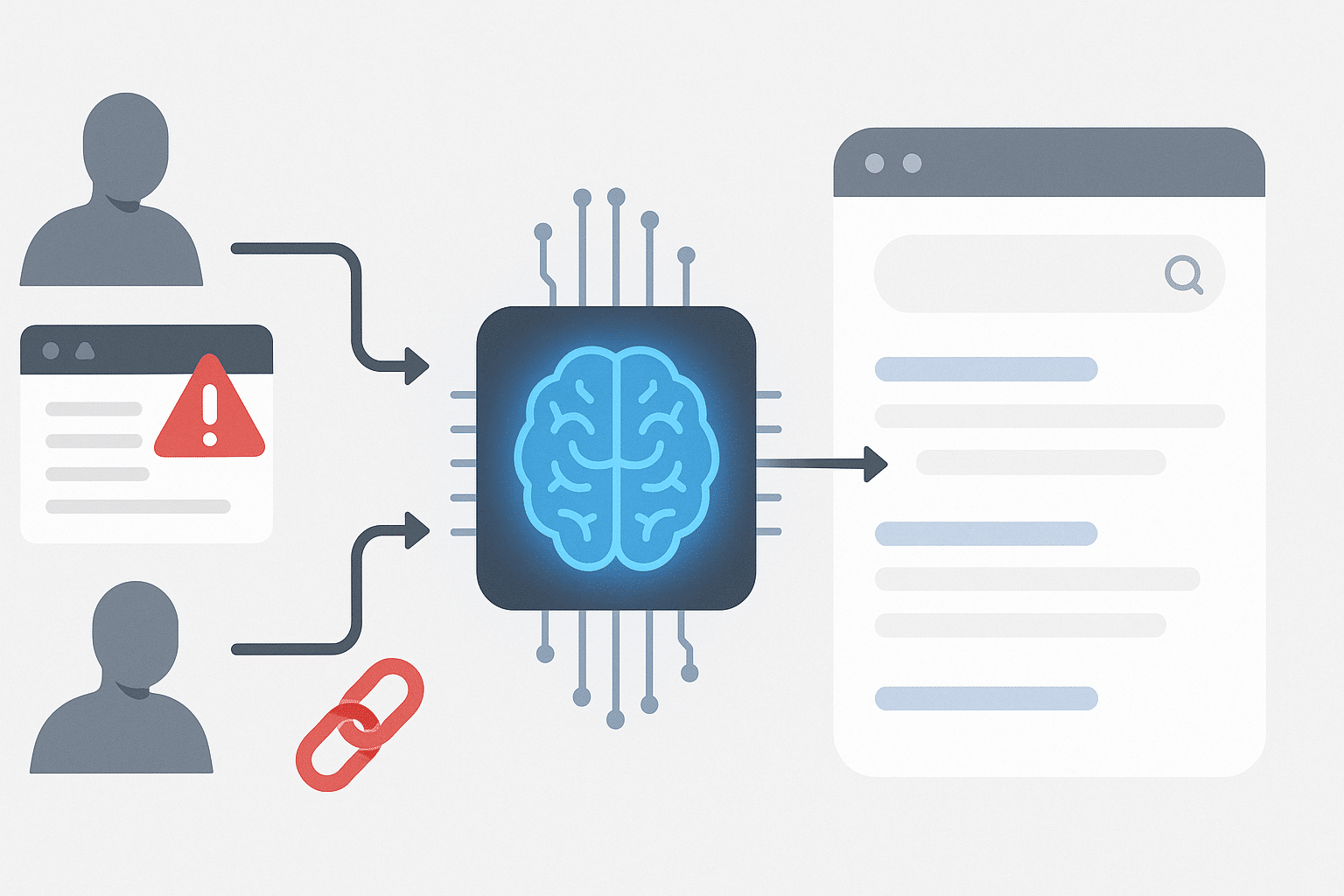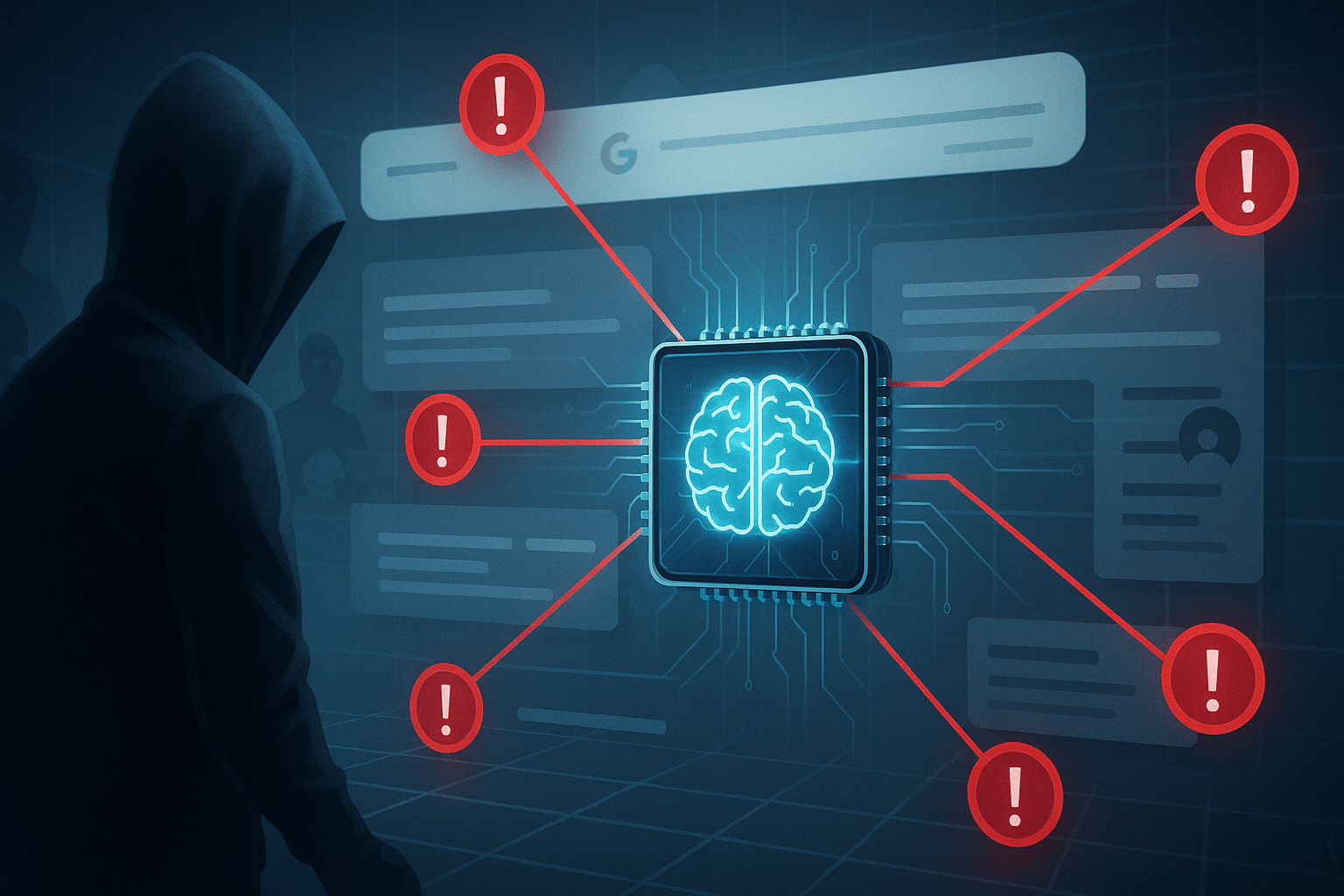SpamBrain is an AI-based spam detection system created by Google to keep its search results clean and safe. It works as a machine learning engine that spots web spam, such as link spam, low-quality content, and tricks that push fake rankings.
SpamBrain began working behind the scenes in 2018, but Google officially revealed it in 2022 as its core spam-fighting system. The company calls it central to keeping over 99 percent of searches spam-free.
What makes SpamBrain powerful is how it keeps learning and updating itself. It tracks new spam tricks and adapts fast, which helps protect search results from harmful and misleading content.
How Google started SpamBrain
Google has worked to block search spam for years, especially websites that try to game the system with low-quality content or link tricks. In earlier times, Google used manual actions where human teams reviewed spammy sites and took them down. The company also built algorithm filters like Google Penguin, launched in 2012, which targeted fake link-building methods.
By the late 2010s, spam tactics had become more complex. In response, Google moved towards AI-based spam detection to catch spam in smarter ways. That shift led to the creation of SpamBrain in 2018.
Move from manual tools to machine learning
Unlike older spam updates that were applied once and updated later, SpamBrain works as a learning system. It is designed to keep adapting, spotting both content spam and link spam as they change. This machine learning model helps detect spam at scale, without needing human reviewers each time.
How it fits with other systems
Even though SpamBrain is the main tool now, Google still uses older systems too:
- Manual webspam actions are still in use for serious spam cases.
- Google Penguin principles (like link devaluation) are part of SpamBrain’s broader detection logic.
How SpamBrain has changed over time
SpamBrain is Google’s AI-based system for detecting and removing search spam. It works in the background to block link spam, hacked content, and other low-quality pages, helping keep search results clean and trustworthy for users.
Quiet launch and early progress
SpamBrain was first deployed inside Google in 2018, but it was not publicly named at that time. For the next few years, Google engineers worked to improve it quietly.
The system was officially named SpamBrain in Google’s Webspam Report published in April 2022. By then, it was already showing strong results. In 2021, SpamBrain was detecting almost six times more spam sites than in 2020. This led to:
- A 70% drop in hacked spam
- A 75% drop in gibberish spam found on hosting platforms
These results helped reduce low-quality websites from appearing in Google Search.
Major upgrades and public rollout
In 2022, SpamBrain was included in Google’s major spam updates. That year, the system showed major improvements:
- It caught five times more spam than in 2021
- It found 200 times more spam compared to when it first launched
The October 2022 spam update was the first to use SpamBrain’s AI to block general spam pages directly from ranking in search results.
Link spam detection and expanded features
In December 2022, SpamBrain’s role was expanded to tackle link spam. This allowed it to:
- Detect paid links and websites that buy or sell backlinks
- Neutralize unnatural links, stopping them from improving ranking
- Catch 50 times more link spam sites than earlier link updates
SpamBrain also improved its ability to find hacked website spam, with a 10× increase in detecting such abuse.
Multilingual updates and ongoing learning
In October 2023, another spam update made SpamBrain more effective in multiple languages, including:- Hindi , Turkish , Vietnamese , Chinese
It also became better at detecting:- Cloaked pages , Scraped content , Auto-generated pages
These improvements were made with help from user-submitted spam reports, which engineers used to fine-tune the system.
Core role in spam prevention
As of 2023, SpamBrain remains the core of Google’s anti-spam system. It runs in the background of Search, learning and adapting every day to catch new spam methods and protect search quality.
How SpamBrain works in Google Search

SpamBrain works as a smart filter in Google Search. It uses AI and machine learning to detect spam, block harmful content during crawling, and stop scam or abusive pages from reaching users through the search index.
Core machine learning platform
SpamBrain works as a machine learning platform that runs multiple spam detection models. It does not rely on a single rule or algorithm. Instead, it uses AI to:
- Scan web content and link patterns
- Detect signals of content spam, link spam, and hacked site abuse
- Learn from new spam examples and improve over time
Google calls it a versatile system, meaning it can be trained to handle many types of spam without building a separate tool for each threat.
Role during crawling and indexing
One key feature of SpamBrain is that it works at the crawling stage. When Googlebot crawls a page, SpamBrain checks if the content looks spammy or malicious. If it does, Google blocks that page from being added to the search index.
This crawl-time filtering also covers:
- Pages submitted through Search Console
- Pages pushed through the Indexing API or sitemaps
This helps stop spammers who try to push spam pages into search faster. By acting early, SpamBrain saves resources and stops spam from appearing in results at all.
SpamBrain as a gatekeeper
SpamBrain’s “gatekeeper” role means it helps decide what gets indexed and what does not. This process happens before the page reaches users. It improves both spam prevention and system efficiency.
Expanded features beyond web spam
Google has expanded SpamBrain’s scope to other types of harmful content, including:
- Scam sites: In 2022, SpamBrain was used to stop scam-related spam across multiple languages. Clicks to scam sites dropped by 50 percent.
- Online abuse and slander: In 2021, SpamBrain helped demote sites involved in name-based extortion or exploitative content, protecting users who searched for their names.
These updates show that SpamBrain is not just for spam. It now supports overall search safety, helping filter out misleading, harmful, or abusive content before it appears to users.
Impact and effectiveness of SpamBrain (Google)
SpamBrain has made Google Search cleaner and safer by blocking spam before it reaches users. With each update, it catches more spam, reduces hacked and link-based abuse, and quietly powers over 99 percent of spam-free search results.
Rapid improvement over time
Since its launch in 2018, SpamBrain has greatly improved how Google handles search spam. In its early days, the system made a small impact. But by 2022, it was removing 200× more spam than it did in its first year.
Each year brought stronger results:
- In 2021, SpamBrain caught 6× more spam sites than in 2020
- In 2022, it identified 5× more spam than in 2021
These gains led to much cleaner search results, with over 99% of visits spam-free—a standard Google says it has maintained since 2019.
Specific spam categories tackled
As SpamBrain evolved, it helped fight many types of abuse:
- After its link spam detection was added, Google quickly spotted and neutralized link networks that were boosting rankings unfairly.
- SpamBrain also sharply reduced hacked website spam, blocking many harmful pages before they could appear in search.
Instead of only penalizing sites after spam appears, SpamBrain works early in the crawl process. It stops bad pages before they enter the index, which means most users never see spam at all.
Spam updates and webmaster impact
Google now includes SpamBrain in its official spam update announcements. These updates reflect major changes to SpamBrain’s algorithms.
If a site’s ranking drops after such an update, Google advises checking for violations of its spam policies. However, unlike older spam filters that issued manual penalties, SpamBrain usually just ignores spam signals, such as bad links. The links stop helping the site, and any ranking boost from spam is lost.
This method means a site isn’t punished harshly—it simply loses any unearned advantage it had.
A new era of spam protection
SpamBrain is now a core part of Google’s search quality system. It uses AI to keep up with changing spam tactics and needs little manual work. Google is still investing in SpamBrain’s future. Each update adds new features, helping keep search results clean.
For users, this protection mostly happens behind the scenes. But the result is clear: a safer, more useful search experience, powered by an AI system that never stops learning.
Reference
- https://www.seroundtable.com/google-webspam-report-2021-spambrain-33289.html
- https://www.ignitingbusiness.com/blog/what-is-google-spambrain-and-how-does-it-prevent-spam-in-search-engine-result-pages-serps
- https://developers.google.com/search/blog/2023/04/webspam-report-2022
- https://en.wikipedia.org/wiki/Google_Penguin
- https://developers.google.com/search/blog/2022/04/webspam-report-2021
- https://developers.google.com/search/blog/2022/12/december-22-link-spam-update
- https://searchengineland.com/google-algorithm-updates-2022-in-review-core-updates-product-reviews-helpful-content-updates-spam-updates-and-beyond-390573
- https://www.searchenginejournal.com/google-webspam-report-spambrain/484448/
- https://developers.google.com/search/updates/spam-updates


